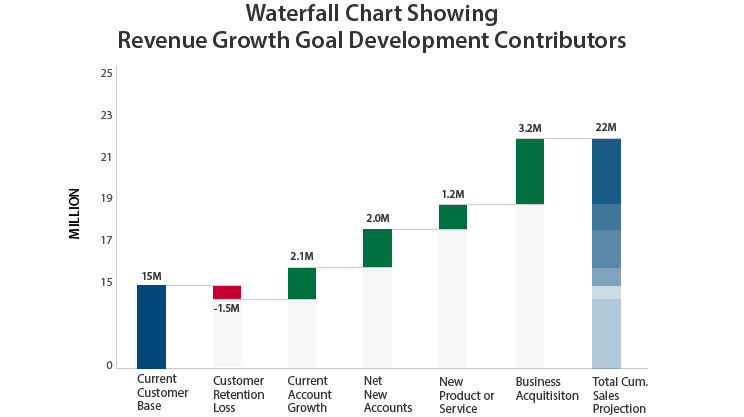As we approach year-end, sales teams are hustling to close Q4 strong, while executives look ahead, setting goals for the new fiscal year. This article provides guidance on how to take a strategic, bottom-up approach to establishing revenue goals that drive success instead of frustration.
In my experience with small and mid-sized businesses, I often see owners and executives fall into two categories when setting revenue targets:
On-Track: This group takes a logical, data-driven approach to develop realistic revenue goals. As a result, their sales plans are cohesive, well-aligned, and rooted in achievable segments.
Unrealistic: The other group takes a top-down goal development approach based on ambition rather than feasibility. More often than not, these goals end up being out of reach, leaving teams discouraged and targets unmet.

If you’re relying on a top-down approach, now is the time to consider a better alternative.
A bottom-up revenue goal development approach is based on realistic projections and strategic planning.
In this article I share knowledge I’ve built-up over decades of experience with the objective to help you build a revenue target that you and your team can believe in.
Once you’ve developed a logic-driven revenue projection, you’ll have the foresight to align your business to achieve the expected result. Let’s get started!
Bottom-Up Approach to Revenue Goal Setting
I’ve seen too many sales teams set up for failure, chasing revenue goals they had no chance of achieving. A bottom-up revenue goal planning approach changes that by starting with a realistic baseline and building upward with measurable growth contributors. This logic-driven method lays the groundwork for success.
Here are the key steps:
Step 1: Calculate Base Revenue
First, define “base revenue” — the revenue you expect from your current customers and existing contracts. Consider historical trends, and don’t forget to account for customer retention loss. While minor for some companies, retention loss can be significant for others.
Accurately projecting your base revenue will give you a realistic starting point. For instance, the base revenue may look like this:
- Current Customer Base: $15M
- Customer Retention Loss: -$1.5M
Your net base revenue should consider the impact of retention and provide an accurate revenue baseline. I position these figures as building blocks in my Waterfall Chart model shown here:

Step 2: Estimate Current Customer Organic Growth
Next, project the organic growth from your existing accounts — revenue beyond the baseline feed you anticipate from existing customers. I position this as the third contributor in my goal development model.
This often involves expanding wallet share through strategic account planning, quarterly business reviews (QBRs), or other relationship-building activities.
While current account organic growth is often the “low-hanging fruit,” it still requires focus and effective sales leadership to capture fully.
In small and mid-sized businesses, this growth segment is often underutilized, especially when top executives double as sales leaders. That’s where a Fractional VP of Sales like me can step in, bringing strategic sales leadership that maximizes the potential of existing accounts.

Step 3: Add New Logo Growth
Layering in New Logo (or Net New) growth is your next step – the fourth revenue goal building block. This projection should consider your historical ability to capture new accounts and the current state of your market.
If you have an established marketing funnel that reliably produces leads, use past performance to estimate new account growth. If not, now is the time to strengthen your partnership between sales and marketing to fuel the pipeline.
Keep in mind that if your industry isn’t rapidly expanding, it’s unrealistic to expect rapid new account growth without substantial investment in lead generation and marketing.
Step 4: Plan for Strategic Growth Initiatives
The last factor to build into your revenue growth equation is various supplemental strategic initiatives.
These serve as the stopgap between what executives are resolved to achieve for their growth trajectory and what is reasonable based on the current state of their sales and marketing teams’ performance.
As shown as the last two contributors on my Waterfall Chart above, I listed New Product ($1.2M) and Business Acquisition ($3.2M) as examples of additive growth initiatives:
Take some time to think about your own product offerings and any new solutions you plan on launching.
- How much capacity or inventory will you have available?
- How steep is the barrier to entry for new solutions you’re bringing to market?
- How do your new offerings stack up against competitive options?

The answers to these questions will guide how conservative or aggressive you apply these growth contributors to your revenue planning calculation.
Other tactics may be strategies you deploy that impact pricing or deal size by asking yourself a series of questions such as…
- Do you need to raise or lower prices?
- Do you plan on adding a new offer that you anticipate will increase the amount you expect to sell?
- What are your competitors doing to take market share?
Note: If you’ve exhausted all internal growth strategies, an acquisition may be worth exploring, though this is a more complex topic for another time.
A Revenue Goal You Can Trust
By following a bottom-up approach, you set a revenue goal that’s grounded in data and realistic expectations, not just optimism.
This approach empowers leaders and sellers alike, aligning everyone with achievable targets, and builds the momentum necessary for a successful year.
Still feeling uncertain? If you’re questioning your revenue projections or the effectiveness of your sales pipeline, I’m here to help. Feel free to reach out to me at 321.229.8910 or smuniz@salesxceleration.com.
———————————————————————————–
I am part of a national group of Fractional Sales Leaders who collaborate to share insights like the examples shown in this article. We formed because of our shared passion to help business leaders exponentially grow their revenue.


